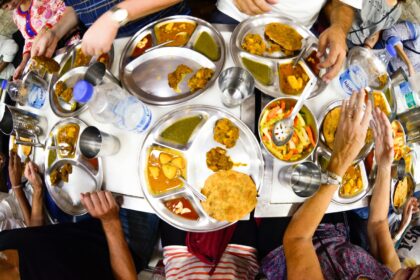
“It isn’t pretty. My kids won’t even eat it because it looks weird. But, it’s delicious and really special for the region.”
My dining companion, a Hamburg local named Guido, and I are at the Restaurant Broscheks in Hamburg’s City Center, choosing our lunch entrees.
When I tell him I want to try something with cultural significance, he immediately urges me to the Labskaus, an important dish in Northern Germany despite its apparently odd aesthetics.
The meal features a mixture of salted minced beef bits, onion and potatoes mushed together with beetroot — which gives it a red hue — topped with a fried egg and gherkin.
On the side, rollmop herring adds some healthy protein.
As someone who’s eaten everything from guinea pig to worm tacos, I feel confident this German staple won’t spoil my appetite. Guido describes to me that it’s a dish he’ll only order at truly high-quality restaurants, as its usually best when home-made.
“Some restaurants will use canned meat and then it isn’t that good,” he explains. “My favorite is when my grandmother makes it.”
When the plate is plopped in front of me I have some reservations.
I’m not afraid of the dish; however, it sort of reminds me of something I would have made my parents when I was a child, mushing a bunch of ingredients into a mash (my dad loved my hot fudge and ketchup balls!). It certainly isn’t as visually appetizing as, say, authentic German sauerbraten.
But once I take a bite of the tasty sweet yet salty concoction, with its hearty and lumpy consistency, I get it.
And as the history of Labskaus is recited to me, it becomes even more clear.

Labskaus History
Labskaus isn’t just any dish, as this local staple was created by sailors in the 16th century who used the ingredients readily available to them — salted meats, canned vegetables and the treasures of the sea.
If you look at Hamburg, Germany, a city practically surrounded on all sides by water, it makes sense the meal would be introduced. Not only was Labskaus a dish for seamen, however, but also the poor, who were known to consume salted meats and pickles.
The origin of the dish’s name isn’t entirely clear, although “scouse” refers to stew and the word “lob” is thought to refer to a word for throwing leftovers into a pot to create a stew.
Interestingly, Labskaus has gone from being a simple, no-fuss meal for peasants and seaman to a dish all classes of the Northern German population can enjoy. In fact, even upscale restaurants today create the meal with modern touches in a sophisticated atmosphere.
Restaurant Information
Restaurant Brocheks
Renaissance Hamburg Hotel
Grosse Bleichen, Hamburg
+49 40 349 18 0
broscheks.de
Have you tried Labskaus? What did you think? Please share in the comments below.
Jessica Festa
Latest posts by Jessica Festa (see all)
- A Culturally-Immersive Adventure In Mongolia’s Altai Mountains - Jul 8, 2023
- This Recipe Sharing Platform Supports Women In The Culinary Industry (Labneh Recipe Included!) - Nov 5, 2020
- Hiking The Mohare Danda Community Eco-Trek In Nepal - Jun 3, 2020
- 6 Important Questions For Choosing A Responsible Yoga Retreat - May 18, 2020
- How To Create & Grow A Profitable Blogging Business (Ethically) - Jan 18, 2020






In Patrick O’Brian’s sea novels he does mention the crew eating Lobscouse 🙂